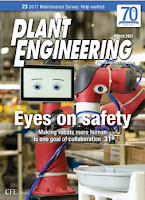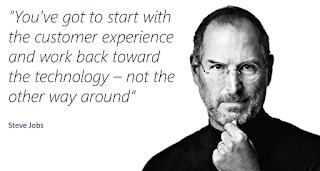Understanding your Customer – A simple tutorial
Most
distributor salespeople identify themselves as solution sellers. Yet, experience dictates only a few dedicate
the time and resources to truly comprehend the drivers behind
customer
decisions. When questioned, most struggle
to understand customer issues outside of their own products. Truth is, their version of solution selling
is mostly service and support wrapped around the technologies they sell. While this wrapping of service and support
probably does justify the “solution seller” mantra, I believe we, as sellers,
will soon be obsolete if we don’t move our attention to providing solutions
which push beyond supporting our line card.
Many agree with this opinion, but just don’t know how to get started.
For
years, I have advocated for distributor sales professionals reading the trade
publications covering their customer’s industry. Because so many of our readers are actively
calling on manufacturing facilities, I thought I would share some comments from
Plant Engineering Magazine. But before
we launch into the meat and potatoes of this piece, allow me a few word on the
magazine.
 Plant
Engineering focuses on things a broad-based plant engineer, maintenance
manager, facilities supervisor and others responsible for keeping the facility
running. Each month there are articles
covering product technology; mostly basics, but containing enough meat for a
newbie seller to gain some insight into the products. For instance, the latest edition (March 2017)
contains an article on selecting the right LED lighting system, a short bit on
thermography and a story outlining the expenses associated with leaking plant
air lines. But the feature story is a
survey of plant engineers (called the Maintenance Report.) And, that is the real deal for all of us in
sales.
Plant
Engineering focuses on things a broad-based plant engineer, maintenance
manager, facilities supervisor and others responsible for keeping the facility
running. Each month there are articles
covering product technology; mostly basics, but containing enough meat for a
newbie seller to gain some insight into the products. For instance, the latest edition (March 2017)
contains an article on selecting the right LED lighting system, a short bit on
thermography and a story outlining the expenses associated with leaking plant
air lines. But the feature story is a
survey of plant engineers (called the Maintenance Report.) And, that is the real deal for all of us in
sales.
Let’s
explore some of the findings….
The
average survey participant has 22 years of experience with 32 percent having
over 30 years of experience. This means
something like a third of these folks are fast approaching retirement. The average facility has 406 employees with a
quarter of the plants pushing over the 500 employee mark. The industries represented are a
representation of manufacturing in North America. Everything from fabricated metals and
pharmaceuticals to automotive and aerospace is represented.
Unscheduled downtime is ripe with selling opportunities…
The
leading causes of unscheduled downtime is aging equipment at 42 percent and operator
error at 19 percent. Lack of time for
maintenance and not maintaining equate to another 24 percent. When asked how these would be addressed, the
answers indicate a number of selling opportunities:
Sixty
(60) percent of the survey respondents point to equipment upgrades as part of their
strategy. Here might be some questions
for a seller:
·
Do
you know which pieces of equipment at your customer’s facility are the most
troublesome for unscheduled downtime? If
not, why not ask?
·
Do
you know the financial impact of loss time from the troublesome equipment? Most facilities fix the machines which have a
high payback first.
·
Are
you calling on the people responsible for machine rebuilding and repair? As strange as it may seem, your “normal”
contacts in engineering and maintenance may not have a handle on the process of
equipment upgrades.
Fifty
(50) percent of the respondents point to improved training and more frequent
training
in their plant. Again, this opens the
doors for a salesperson. Here are some
questions:
·
What
are your customer’s training needs? Many
don’t actually know what exactly would drive greater uptime (and more revenue)
to their facility.
·
What
training offerings could the technical people tied to your organization
provide? Typically, the local community
colleges, who are often working to get training dollars, have neither customer
specific knowledge nor real world fundamentals tied to the equipment in place.
·
Could
you offer training to “non-technical” people to bring up the level of
competency of machine operators on the plant floor? Typically, this is not something the plant
engineering people have a handle on.
Instead, this comes under the purview of production and HR
personnel. Do they even know who you
are?
Between
45 and 50 percent of the facilities are looking towards preventative
maintenance and remote monitoring strategies for attacking unplanned downtime. This is another selling opportunity. Continuing with questions:
·
Do
you have products with monitoring capabilities built in? Looking backward, if you know the machines
which might be updated and you have products with monitoring capabilities, you
could position your company to partner on the projects.
·
A
few very progressive distributors have added services to their product
offerings. Are you one of these
companies? If so, now might be the time
to fine tune and relaunch your offering as a customer driven service.
The
average facility is outsourcing nearly one fifth of their maintenance work. For distributors who have embraced the
fee-based service model, this could result in added revenue. For those who do not sell services, it
probably means you will be called on to provide added services for free, and
that drags down profitability. Decidedly
against working fee-based services? I
suggest locating and cultivating a relationship with an outside source. Acting as a conduit for new business will
position you for making new sales.
Where to start? A
real life strategy…
We
started our conversation on the topic of reading customer-centric publications
as a tool for understanding customers.
Let’s continue this thought.
·
What
would happen if you scheduled an appointment with the Plant Engineering Manager
or Facilities Manager of your customer and showed up with this survey in
hand?
·
What
would happen if you shared a copy and asked how the findings aligned
with her location?
There
is an excellent chance the following conversation would result in a better
understanding of your customer’s situation.
During the conversation, remember to follow this time tested set of
guidelines:
·
Prepare
questions ahead of time so they are on the top of your mind. Many of the points outlined above can be
morphed into great customer questions.
·
Avoid
launching into “product spiels.” The
time for selling is later.
 ·
Whenever
possible direct the conversation to money.
What are costs associated with downtime and how could improving productivity
affect the bottom line are good questions.
·
Whenever
possible direct the conversation to money.
What are costs associated with downtime and how could improving productivity
affect the bottom line are good questions.
·
Listen
for the names of people in the production department who might benefit from
training.
·
Take
careful notes and ask if you can repeat back important points.
And
for future reference, the website for Plant Engineering is here. I recommend you review the report which is listed under research. It’s free and I believe will drive
business. How cool is that?




Comments
"The more you can minimize downtime, the more you can improve throughput and quality,"
2016 Industry Week best plant winner.
The whole article is here...
http://www.industryweek.com/industryweek-best-plants/2016-iw-best-plants-winner-no-time-downtime-intertape-polymer-group?utm_source=feedburner&utm_medium=feed&utm_campaign=Feed%3A+IWNews+%28IndustryWeek+Most+Recent+News%29&sfvc4enews=42&cl=article_1&NL=IW-07
Six Sigma Certification in India | Lean Six Sigma Certification in India
MaxMunus Offer World Class Virtual Instructor led training on portfolio management black belt. We have industry expert trainer. We provide Training Material and Software Support. MaxMunus has successfully conducted 100000+ trainings in India, USA, UK, Australlia, Switzerland, Qatar, Saudi Arabia, Bangladesh, Bahrain and UAE etc.
For Demo Contact us.
Nitesh Kumar
MaxMunus
E-mail: nitesh@maxmunus.com
Skype id: nitesh_maxmunus
Ph:(+91) 8553912023
http://www.maxmunus.com/